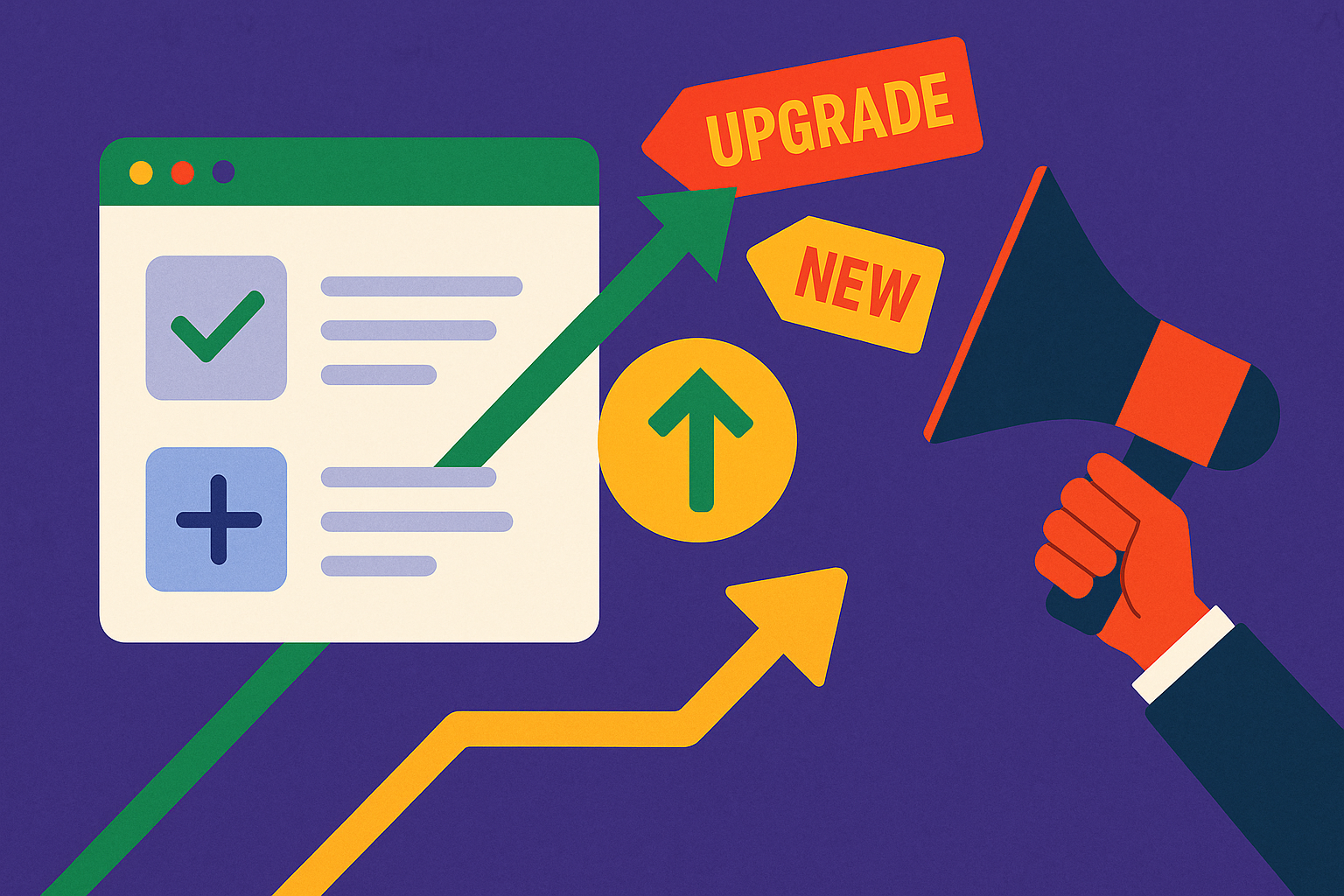Key Takeaways
- A great changelog is user-focused, not product-focused.
- Use our 3-part formula: Headline → Scannable Format → CTA.
- Visuals and a conversational tone can make updates more engaging.
- Treat changelogs as a strategic tool—they can drive feature adoption, reduce support tickets, and improve user retention.
Introduction
You’ve just shipped an exciting new feature or update, and you’re eager for your users to notice. But instead of a flood of engagement, there’s silence. Sound familiar?
Many product teams struggle with getting users to engage with updates. A stale changelog—buried in an email or tucked away in a dashboard—isn’t enough to capture user attention.
Worse, invisible updates lead to low feature adoption, more repetitive support tickets, and frustrated teams wondering if the work they put in was worth it.
At SimpleDirect, we’ve turned changelogs into a powerful tool for communication, driving feature adoption, and building trust with users.
The result? Open rates as high as 60%, feature adoption spikes, and fewer support tickets.
In this article, we’ll share the exact 3-part changelog formula we use to get these results.
You’ll learn how to create changelogs that users actually read, avoid common pitfalls, and see real-world examples to inspire your next update.

Why This Matters
The Cost of Invisible Updates
If users don’t know about your updates, they can’t engage with them. Here’s what’s at stake:
- Missed Opportunities for Feature Adoption: According to a Userlane report, 70% of users stick to familiar features and workflows, ignoring updates unless they’re clearly communicated.
- Increased Support Volume: A poorly communicated update can lead to a 10-20% spike in support tickets, as users fail to discover or understand new features.
- Lower Retention Rates: Engaged users are 50% more likely to renew subscriptions, but they need to see value in your updates to stay engaged.
The Quick Win Potential
A well-crafted changelog is one of the easiest ways to:
- Boost Feature Discovery: Make users aware of updates and encourage them to try new features.
- Reduce Support Workload: Proactively answer common questions and highlight fixes.
- Re-Engage Dormant Users: A well-timed update can bring back inactive users.
The best part? You don’t need to overhaul your communication strategy. A simple changelog update can make a massive difference.
The 3-Part Changelog Formula That Gets 60% Open Rates
Our changelog formula is built on three principles:
- Hook Your Reader with a Clear, User-Centric Headline
- Make It Scannable with a Structured Format
- Close with a Call-to-Action (CTA) That Drives Engagement
Let’s break each one down, step by step.
- Hook Your Reader with a Clear, User-Centric Headline
The headline is the first thing users see. Its job? Grab attention and communicate value—fast.
Why It Works
Most changelogs fail because their headlines are vague or boring. Phrases like “Product Update - October 2025” don’t tell users why they should care. Instead, your headline should highlight the benefit of the update.
Examples of Effective Headlines
"Bug Fixes + 3 Productivity Boosters You’ll Love"
"Faster Checkout Is Here: Save Time on Every Order"
"New Feature: Schedule Posts Across Time Zones with Ease"
Headline Best Practices
- Be Specific: Highlight the most important update or feature.
- Focus on User Benefits: Instead of describing the feature, explain what it helps your users do.

- Make It Scannable with a Structured Format
Users don’t have time to read long, dense updates. That’s why a clear, scannable format is critical.
The Ideal Changelog Structure
- Organize Smaller Updates with Bullet Points
Use bullet points to break down minor improvements or bug fixes.
Example:- Fixed: Search results now load 30% faster.
- Improved: Dark mode contrast for better readability.
- Added: Keyboard shortcuts for faster navigation.
- Add Visuals for Clarity
Visuals make changelogs more engaging and easier to understand. Include screenshots, GIFs, or short videos to show off features.
Highlight Key Updates First
Start with the most impactful feature or fix.
Example: “You can now tag teammates in comments to speed up collaboration!”
Real-World Example
| Example Changelog Section | Example Content |
|---|---|
| Key Update | “Save time with our new scheduled notifications feature. Perfect for teams working across time zones!” |
| Minor Updates | - Fixed: Time zone syncing issues. <br> - Improved: Notification settings now save automatically. <br> - Added: Keyboard shortcuts for faster navigation. |
| Visual |
Pro Tip: Add a Personal Touch
Use a conversational tone to make your changelog feel more approachable. Instead of:
- Corporate Tone: “The system has been enhanced to optimize performance.”
Use: - Conversational Tone: “We’ve made the dashboard faster and easier to navigate—you’ll notice the difference right away!”
- Close with a Call-to-Action (CTA)
Every changelog is an opportunity to engage users further. A strong CTA encourages them to take the next step.
Examples of Effective CTAs
- “Try this feature today—click here to get started!”
- “Watch this quick 2-minute video to see the feature in action.”
- “Have feedback? Reply to this email or share your thoughts here.”
Why CTAs Matter
- They encourage immediate action, such as trying out a new feature.
- They create a feedback loop, strengthening trust with your users.

Real Example: Our Changelog in Action
Here’s how we implemented this formula for our “Scheduled Notifications” feature.
| Step | Example |
|---|---|
| Headline | “ You Can Now Schedule Notifications—Save Time and Stay Organized!” You Can Now Schedule Notifications—Save Time and Stay Organized!” |
| Key Updates | - Save time by scheduling notifications in advance. <br> - Perfect for teams working across time zones. |
| Visual | |
| CTA | “Try scheduling your first notification today, or check out our quick start guide for more details!” |
Results:
- Open Rate: 64%
- Feature Adoption: 40% of active users tried scheduling notifications within the first week.
- Support Tickets: Related questions dropped by 25% compared to similar feature launches without a structured changelog.
How to Get Started
Here’s how you can apply our formula to your next changelog:
| Step | Action |
|---|---|
| Draft Your Headline | Write 2-3 options that focus on user benefits, and pick the most compelling one. |
| Organize Your Updates | Separate major features, minor updates, and bug fixes into clear sections. |
| Add Visuals | Include screenshots, GIFs, or videos to make your updates more engaging and clear. |
| Write a CTA | Decide what action you want users to take—trying the feature, giving feedback, or watching a demo. |
| Test and Optimize | Track open rates, clicks, and feedback to refine your changelog strategy over time. |






